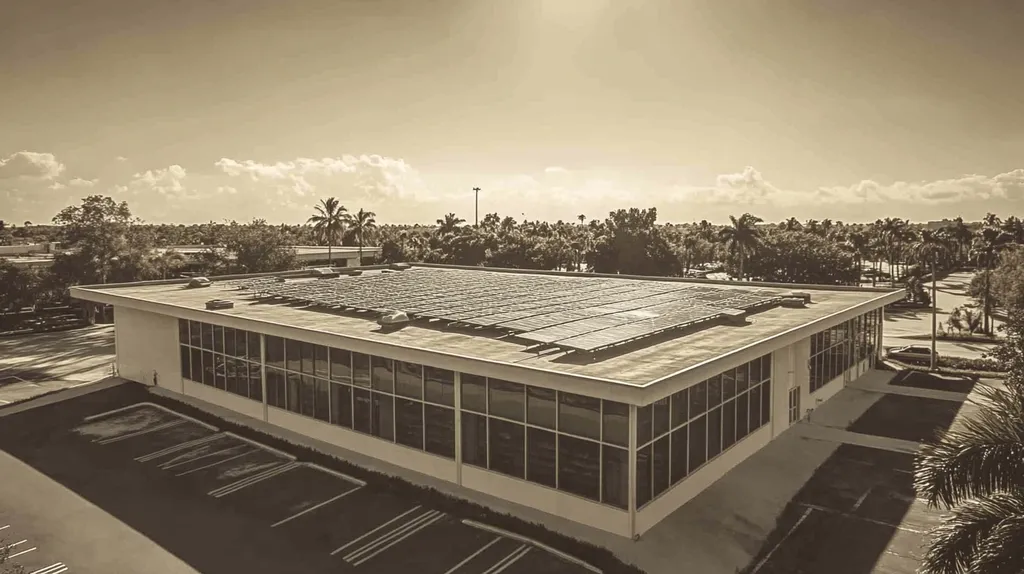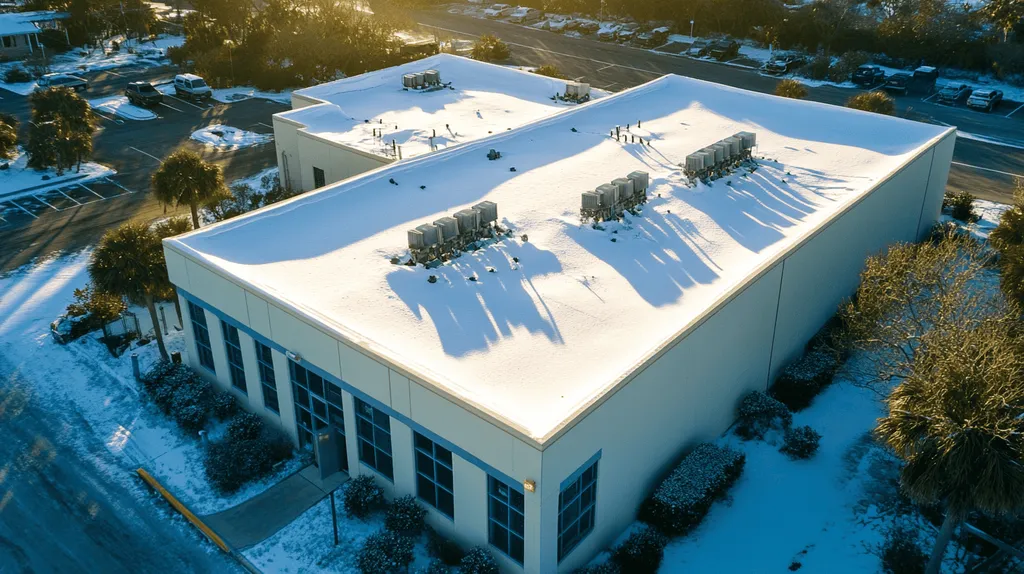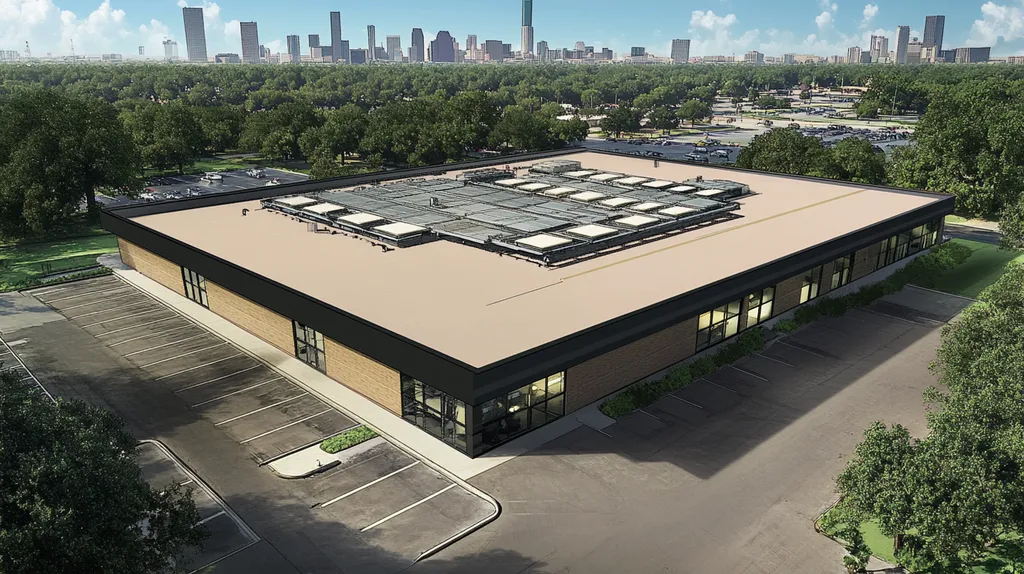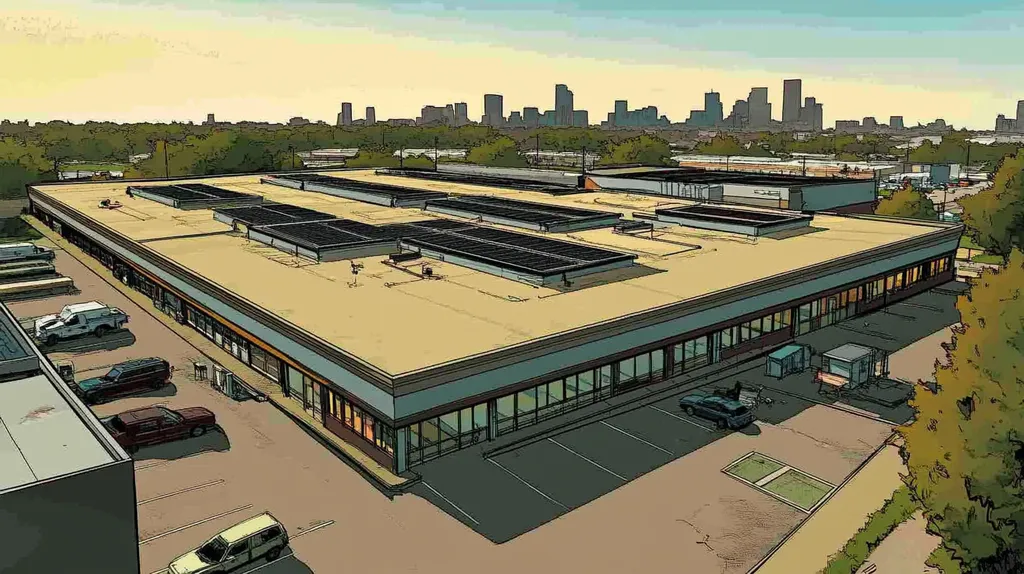In today’s volatile climate, understanding how weather impacts commercial roof warranties has become more critical than ever. Recent industry data shows that weather-related warranty claims have surged by 47% over the past decade, with billions in denied coverage due to preventable oversights.
From scorching heat waves to unprecedented storm systems, modern roofing materials face challenges that early builders could never have anticipated. Yet the fundamental principles of protection remain unchanged.
This comprehensive guide examines the intricate relationship between weather conditions and warranty coverage, equipping property owners with essential knowledge to safeguard their roofing investments for decades to come.
SECTION 1: FUNDAMENTAL CONCEPTS
Grasping the complexities of commercial roof warranties is crucial for property owners and facility managers alike. With a staggering 40% of building maintenance expenses attributed to roofing issues, the stakes for protecting investments have never been higher. Weather elements like fierce winds, heavy snow, and extreme temperatures can significantly influence the longevity and effectiveness of roofing materials, as well as the validity of warranty claims. This section explores the various types of warranties, their coverage, and the responsibilities of both manufacturers and contractors in safeguarding your roof against the elements.
Types of Commercial Roof Warranties
Commercial roof warranties typically fall into two primary categories: manufacturer warranties and contractor warranties. Manufacturer warranties focus on defects in materials, assuring that the roofing products perform as intended. These warranties can vary in duration, generally ranging from 10 to 30 years based on the quality of materials used.
Contractor warranties, conversely, ensure the quality of the installation work. These warranties can differ considerably, spanning from 1 to 10 years. Both warranty categories play a vital role in understanding the protection offered to property owners, particularly as severe weather conditions can lead to premature roof failures.
Additionally, many warranties stipulate the necessity of regular maintenance and inspections. Neglecting these responsibilities can invalidate the warranty, leaving owners exposed after weather-related damage strikes.
Carefully examining the specifics of each warranty is essential, as protections can vary significantly depending on the roofing system and local environmental factors. Identifying gaps in coverage can greatly influence repair decisions and long-term maintenance strategies.
Coverage for Materials and Workmanship
Material coverage typically protects against defects in manufacturing, while workmanship coverage focuses on the quality of installation. Both types are necessary for ensuring a roof’s optimal performance over time. However, external weather conditions can heavily influence these coverages, potentially validating or invalidating claims.
For instance, high winds may cause shingles to become dislodged, leading to potential disputes over warranty claims. Manufacturers could challenge claims arising from damage caused by conditions they deem outside of “normal wear and tear.” Property owners must grasp the limitations of their coverage regarding extreme weather encounters.
Moreover, it is vital for property owners to remain proactive throughout the warranty period. Keeping comprehensive records of maintenance and inspections can significantly strengthen their position in case of disputes. Proper documentation demonstrates adherence to warranty requirements and clarifies responsibilities during weather-related incidents.
Understanding warranty specifics promotes a proactive maintenance approach. A roof that receives regular inspections and upkeep is far less likely to suffer catastrophic failure, especially as weather patterns become increasingly unpredictable.
Understanding Manufacturer and Contractor Warranties
Manufacturer warranties offer two main levels of coverage: materials and defects. If roofing materials fail prematurely due to manufacturing flaws, property owners may receive replacement materials at no charge. However, it is important to recognize that such warranties often exclude damages stemming from weather-related occurrences.
Contractor warranties emphasize the quality of installation and may cover issues arising from subpar workmanship. These warranties vary in both duration and scope, underscoring the need to select qualified contractors. A reputable contractor will transparently outline their warranty coverage, particularly concerning weather impact.
Both warranty types can face complications stemming from actual weather events. Severe hail or excessive rain may lead to damages not covered under standard warranties. It is crucial to examine how these external factors are defined in warranty terms.
In conclusion, property owners should not only seek comprehensive warranties but also educate themselves about how weather considerations influence their claims. A clear understanding of both manufacturer and contractor responsibilities equips owners to navigate warranty-related challenges effectively when they arise.
SECTION 2: SYSTEM COMPONENTS
The choice of roofing materials and installation methods is crucial for a commercial roof’s resilience against harsh weather conditions. Subpar materials can lead to significant warranty disputes and unexpected repair costs. In fact, studies show that roofs made with low-quality products experience a staggering 30% higher failure rate within just five years. For property owners and facility managers, understanding the key components of a roofing system is vital to safeguard their investments and ensure long-term performance.
Roofing Materials and Their Durability
The durability of roofing materials directly influences a roof’s ability to withstand severe weather. Options such as TPO, EPDM, and metal each boast unique characteristics designed for various climates. For instance, TPO stands out for its outstanding UV resistance, making it a go-to choice for areas with abundant sunshine.
On the other hand, EPDM performs exceptionally well in regions with heavy rainfall due to its superior waterproofing properties. It’s essential to recognize that selecting the right material isn’t solely a financial decision; longevity and performance during extreme weather are key factors. Quality materials maintain their structure and functionality in the face of wind, hail, and temperature changes.
Durability plays a pivotal role when it comes to warranty coverage. Manufacturers often support their products with extensive warranties, contingent on meeting specific performance standards. Therefore, investing in high-quality materials not only strengthens warranty claims but also protects against potential damages.
By opting for cheaper alternatives, property owners expose themselves to the risk of premature roof failures and challenges concerning warranty validation. In the long run, spending a little more on durable materials can lead to significant savings and peace of mind.
Installation Methods and Standards
The quality of the installation process is just as important as the materials chosen. An improperly installed roof can undermine the advantages of even the finest materials. Adhering to industry standards during installation is critical for maintaining warranty protection.
For example, inadequate sealing of roof seams can lead to leaks, which often fall outside warranty coverage. Many manufacturers require specific installation techniques that must be meticulously followed to ensure warranties remain valid.
Engaging experienced contractors who understand local weather challenges can further enhance the roof’s ability to withstand environmental stressors. Continuous training and education on the latest roofing technologies ensure installers deliver consistent, high-quality workmanship.
A thorough inspection post-installation can help identify potential issues before they escalate. Documenting the installation process and confirming compliance with industry standards will fortify property owners’ positions when addressing future warranty claims.
Ignoring proper installation techniques can trigger disputes over warranty claims. To mitigate these risks, property owners should prioritize hiring certified contractors renowned for their expertise.
Edge Metal Systems and Accessories
While often overlooked, edge metal systems and accessories are critical to a roofing system’s performance. These components protect the edges of the roof from water intrusion and environmental damage. Insufficient edge detailing can result in severe leaks and costly interior repairs.
Specialized edge metals, such as coping caps and gravel stops, ensure effective water runoff, preventing accumulation that could weaken the roof structure over time. In many cases, manufacturers may mandate specific edge installations to uphold warranty validity.
Additionally, the installation of essential accessories like vents and drains impacts the roofing system’s overall functionality. Properly placed and installed accessories facilitate efficient water drainage, reducing the risk of standing water that can compromise roof integrity.
To maintain roof health and uphold warranty claims, regular maintenance and inspections of these edge systems are vital. Missing or damaged edge metal can significantly increase the risk of water infiltration.
Property managers should recognize the importance of these components in preserving warranties and ensuring the overall longevity of their roofs. Investing in quality edge systems strengthens the entire structure, providing lasting value.
SECTION 3: IMPLEMENTATION METHODS
In the world of commercial roofing, ensuring weather resistance is far more than a guideline; it’s a critical mandate. With a 2022 study revealing a shocking 25% increase in roof-related claims attributed to natural disasters, property owners and facility managers must take proactive measures to safeguard their investments. This section delves into the essential design requirements, precise installation techniques, and additional coverage options that collectively fortify roofs against the relentless forces of nature.
Design Requirements for Weather Resistance
When creating a commercial roof, an in-depth understanding of local weather patterns is imperative. Roofs should be engineered with materials suited to their environment, ensuring resilience against heavy rainfall, snow accumulation, or strong winds. For example, thermoplastic polyolefin (TPO) provides excellent UV resistance, making it ideal for sun-drenched regions, while modified bitumen can offer superior protection in colder climates.
Equally important is the design of drainage systems to prevent water accumulation, which can lead to leaks and structural issues. Strategic elements, such as parapet walls and sloped roofs, can significantly enhance drainage efficiency and prolong the roof’s lifespan. Neglecting these design aspects not only risks warranty voiding but can also lead to extensive and costly repairs.
Energy efficiency should also be a key design consideration. Reflective roofing materials not only diminish heat absorption but also contribute to building comfort and may fulfill energy code requirements, potentially extending warranty periods. Careful attention to these design specifics can dramatically enhance the roof’s capacity to withstand extreme weather.
Ultimately, investing time and resources in thoughtful design pays dividends, resulting in a robust roofing system that meets warranty standards and withstands the test of nature.
Installation Techniques for Severe Weather
The success of a roof in harsh weather hinges on the adoption of proper installation techniques. Industry standards require that roofing systems be executed according to specific protocols to maximize resilience. For instance, roofs located in hurricane-prone zones must include advanced fastening methods to mitigate wind uplift risks.
Incorporating high-quality underlayment and waterproof membranes can dramatically enhance protection against moisture intrusion. Roofing professionals should ensure that all seams and joints are meticulously sealed to prevent leaks, particularly during intense rain or rapid snowmelt. For flat roofs, maintaining a minimum pitch is advisable to promote effective water runoff and minimize pooling risks.
Training crews in specialized installation practices for severe weather conditions helps reduce future warranty claims. Many manufacturers offer precise guidelines to ensure installations align with warranty requirements. Compliance with these protocols not only boosts roof performance but also fortifies the property owner’s investment.
Additionally, conducting routine inspections during and after the installation process is crucial to maintaining roof integrity. This proactive stance not only validates warranty coverage but also fosters a culture of quality and accountability in roofing practices.
Additional Coverage Options for Weather Events
Property owners can also seek flood and windstorm insurance to complement their roofing warranties. Such policies can cover damages excluded by standard warranties, such as deterioration from flooding or wind uplift issues from severe storms. This multi-faceted approach to insurance can ensure comprehensive protection throughout the lifecycle of the roofing system.
While investing in these additional coverage options may incur upfront costs, they can be invaluable in avoiding substantial financial losses during extreme weather events. Such preemptive measures guarantee that property owners remain protected against the unforeseen chaos that nature can unleash.
Ultimately, by grasping and implementing these additional coverage options, property owners can significantly enhance the longevity of their roofs, creating a stronghold against the unpredictable vagaries of weather.
SECTION 4: MAINTENANCE REQUIREMENTS
Neglecting the upkeep of a commercial roof can lead to exorbitant repair costs and even the voiding of warranties. Statistics reveal that nearly 30% of roofing warranties fall victim to insufficient maintenance. Proper care not only prolongs the lifespan of the roof but also helps ensure adherence to warranty stipulations. This section underscores the crucial maintenance tasks that property owners and facility managers must prioritize to protect their investments.
Regular Inspection and Documentation
Regular inspections are vital for catching potential issues before they escalate into significant problems. Property owners should aim to schedule these assessments at least twice a year, ideally in the spring and fall.
Thorough documentation is key. Keeping detailed records of each inspection—including observations and any corrective actions taken—serves as invaluable evidence if a warranty claim surfaces.
It’s important to include notes on any adverse weather events impacting the roof, such as storms or heavy snowfall. This information can help manufacturers assess claims more effectively.
Hiring a professional roofing contractor for thorough inspections can offer deeper insights. Experienced contractors can identify hidden issues and ensure that maintenance meets warranty specifications.
Adhering to Manufacturer Specifications
Every type of roofing system comes with specific manufacturer guidelines that outline required maintenance and repair procedures. Following these guidelines is essential for preserving the warranty.
Property owners should regularly review their manufacturer’s maintenance manual to remain knowledgeable about necessary practices. This could involve particular cleaning methods, types of sealants, and approved materials for repairs.
Using contractors who are familiar with the roofing system is crucial. Some manufacturers even require that only certified contractors perform warranty-covered work to ensure all standards are met.
Staying compliant with these specifications reduces the likelihood of warranty disputes. Proper care not only maintains compliance but also improves the roof’s overall performance and resilience in facing weather challenges.
Preventing Neglect-Related Damage
Neglecting maintenance can lead to extensive damage that jeopardizes both the roof’s integrity and the warranty. Issues such as clogged gutters or debris build-up can result in water backups and leaks, accelerating material degradation.
Facility managers should implement a proactive maintenance schedule to tackle these issues effectively. Regular tasks should include cleaning gutters, removing debris, and consistently checking for wear and tear on roof membranes.
By prioritizing maintenance, property owners not only protect their investments but also maintain the roof’s structural integrity. Damage from neglect is often costly to repair and can void warranties, leading to further financial burdens.
Establishing an effective maintenance strategy ensures compliance and extends the roof’s lifespan, ultimately safeguarding the property’s value against unpredictable weather-related challenges.
SECTION 5: PERFORMANCE METRICS
For property owners and facility managers, understanding performance metrics is not just beneficial—it’s vital to preserving roofing investments. Weather-related damage can lead to significant financial losses if overlooked or addressed too late. Alarmingly, studies indicate that 80% of roof failures are directly linked to the effects of weather and the quality of installation. This section focuses on evaluating weather damage, assessing workmanship and material quality, and monitoring environmental impacts that influence commercial roof warranties.
Evaluating Weather Damage and Leaks
Recognizing and evaluating weather damage is critical for maintaining a commercial roof’s integrity. Property owners must routinely inspect for signs of leaks, cracks, or blistering aggravated by rain, snow, or intense sunlight. Experts observe that even minor water intrusion can escalate into severe situations, leading to mold growth and structural degradation.
Advanced technologies like infrared thermography have emerged as powerful tools in identifying hidden moisture without invasive methods. Using such technology allows for timely interventions, which can prevent more extensive and costly repairs down the line.
Furthermore, documenting any weather-related damage is essential for filing warranty claims. Maintaining a thorough log of inspections and repairs lays a strong foundation for addressing disputes regarding warranty coverage. This proactive approach not only secures the roofing system’s integrity but also shields the property owner’s financial interests.
To optimize maintenance schedules, property owners should consider establishing regular inspections based on local weather patterns. By adapting preventive measures to specific climate conditions, they can reduce risks and extend the life of their roofs.
Assessing Workmanship and Material Quality
The quality of workmanship and materials plays a pivotal role in a roof’s resistance to weather conditions. Poor installation practices can render even the best materials vulnerable to leaks and structural weaknesses. It is crucial for property owners to verify that their roofing contractors adhere to industry standards during the installation process.
Equally important is the selection of materials. Using durable roofing products specifically engineered to withstand extreme weather can significantly mitigate the risk of warranty claims. For example, thermoplastic polyolefin (TPO) or polyvinyl chloride (PVC) membranes are known for their performance in challenging climates, whereas traditional bitumen might not offer the same level of resilience.
Conducting visual inspections during and after installation can reveal potential problems early. Property owners should ensure open communication with roofing contractors regarding the materials used and the quality of workmanship, helping align expectations and reduce the likelihood of disputes in the future.
It’s also important to keep detailed records of warranties, material specifications, and service history. In the event of damage, having this information readily available can facilitate smoother warranty claims and ensure that property owners receive the coverage they deserve.
Monitoring Wind Speed and Hail Impact
Wind and hail pose substantial risks to commercial roofs, emphasizing the need for ongoing monitoring. Roofs situated in areas prone to severe weather face heightened vulnerability, directly impacting the structural integrity and validity of warranties. After severe storms, regular assessments are vital to identify any visible damages.
Many roofing systems come with defined wind resistance ratings that property owners need to understand. For instance, a roof rated to withstand winds of 90 mph may be at risk if local winds frequently exceed this threshold, potentially resulting in invalidated warranties if damage occurs during such events.
Moreover, hail damage can manifest in numerous ways, including punctures and granule loss. Owners are encouraged to document conditions immediately following a hailstorm to bolster warranty claims. Collecting photographs and damage reports provides essential evidence when engaging with manufacturers or contractors.
Implementing a weather monitoring protocol can enable property owners to stay informed of hazardous conditions in real-time. By remaining vigilant in monitoring and documentation, property owners can ensure their roofs remain in peak condition and warranties stay intact.
SECTION 5: PERFORMANCE METRICS
Understanding performance metrics is crucial for property owners and facility managers who aim to protect their valuable roofing investments. The stakes are high—weather-related damage can lead to steep financial losses if not monitored and addressed swiftly. Alarmingly, studies reveal that 80% of roof failures are directly tied to weather conditions and the quality of installation. This section focuses on how to evaluate weather damage, assess workmanship and materials, and monitor environmental impacts affecting commercial roof warranties.
Evaluating Weather Damage and Leaks
Recognizing and evaluating weather damage is vital for maintaining the integrity of a commercial roof. Property owners should be vigilant, inspecting regularly for signs of leaks, cracks, or blistering caused by rain, snow, or relentless sun exposure. Experts emphasize that even minor water intrusion can escalate into significant issues like mold growth and structural deterioration.
Advanced tools such as infrared thermography have become invaluable for detecting hidden moisture without invasive methods. This technology allows professionals to identify problem areas early, reducing the risk of costly repairs later on.
Proper documentation of any weather-related damage is essential when filing warranty claims. Keeping a detailed log of inspections and repairs creates a solid foundation for addressing disputes about warranty coverage. This proactive approach helps preserve the roof’s integrity and protects the property owner’s financial interests.
Establishing a maintenance schedule tailored to local weather conditions can further mitigate risks and extend the lifespan of roofs. By proactively adapting preventive measures, property owners can significantly enhance roof durability against diverse weather challenges.
Assessing Workmanship and Material Quality
The quality of both workmanship and materials heavily influences a roof’s ability to endure harsh weather conditions. Poor installation practices can leave roofs vulnerable to leaks and damage, making it essential for owners to ensure their contractors adhere to industry standards and best practices throughout the installation process.
Equally important is the choice of materials. Durable roofing products specifically designed to withstand extreme conditions, such as TPO or PVC membranes, can significantly lower the likelihood of warranty claims. Conversely, traditional bitumen may not offer the same level of resilience.
Conducting visual inspections during and after installation is critical for identifying potential issues. Property owners should maintain transparent communication with roofing contractors about the materials used and the quality of workmanship to align expectations and preempt future disputes.
Maintaining comprehensive records of warranties, material specifications, and service history is crucial. This information becomes essential if damage occurs, facilitating smoother warranty claims and helping property owners ensure they receive the coverage they deserve.
Monitoring Wind Speed and Hail Impact
The threat posed by wind and hail to commercial roofs underscores the necessity of ongoing monitoring. Roofs situated in regions susceptible to severe weather face heightened vulnerability, which can compromise both structural integrity and warranty validity. Regular post-storm assessments are vital for identifying immediate issues.
Many roofing systems have defined wind resistance ratings that property owners must understand. For instance, a roof rated for 90 mph winds may risk warranty voiding if local wind speeds frequently exceed this threshold. Such discrepancies could lead to substantial financial repercussions if damage occurs during extreme weather.
Moreover, hail damage can manifest in various forms, including punctures and granule loss. Property owners should document conditions right after a hailstorm to build a solid case for warranty claims. Collecting thorough photographs and damage reports is essential when engaging with manufacturers or contractors.
Establishing a weather monitoring protocol can help property owners stay informed about hazardous conditions in real-time. By remaining proactive in monitoring and documentation, they can ensure their roofs perform optimally while safeguarding the integrity of their warranties.
Looking Ahead
With weather-related roofing claims increasing 47% in just the past decade, understanding the interplay between climate conditions and warranty coverage has never been more critical for property owners.
The evolution from traditional built-up systems to today’s advanced synthetic membranes showcases how far roofing technology has progressed in protecting commercial investments.
Yet even the most sophisticated materials require vigilant maintenance, proper documentation, and a thorough grasp of warranty specifications to ensure long-term protection.
As climate patterns become increasingly unpredictable, facility managers who prioritize comprehensive warranty coverage while maintaining detailed compliance records will be best positioned to protect their roofing investments for decades to come.
The future of commercial roofing lies not just in advancing materials, but in the strategic integration of weather considerations into every aspect of warranty and maintenance planning.
FREQUENTLY ASKED QUESTIONS
Q. What types of commercial roof warranties exist?
A. There are manufacturer warranties and contractor warranties. Manufacturer warranties guarantee material defects and can last between 10 to 30 years. Contractor warranties focus on installation quality, with durations ranging from 1 to 10 years.
Q. How do I choose the right materials for my industrial roof?
A. Selecting durable materials like TPO or EPDM is essential for performance against harsh elements. Assess specific environmental needs, as various materials possess unique resistances tailored to different conditions.
Q. What design considerations enhance a commercial roof’s weather resistance?
A. Crucial design elements include proper drainage systems, sloped roofs, and materials suited for local weather. These factors collectively enhance a roof’s performance and lifespan in adverse conditions.
Q. How often should I perform maintenance on my commercial roof?
A. Regular inspections should occur at least twice a year, ideally in spring and fall. Proper documentation of maintenance actions is crucial for maintaining warranty compliance and identifying potential issues early.
Q. What are key performance metrics for a commercial roof?
A. Monitoring for leaks, evaluating workmanship, and assessing material durability are key metrics. Maintaining detailed records and adapting inspection schedules according to local weather can bolster overall performance and longevity.
Q. How can wind and hail impact commercial roofs?
A. Wind can cause roof dislodgement and hail can create punctures, both risking warranty validity. Post-storm inspections are vital to assess damages and document conditions for potential warranty claims.
Q. What additional insurance options should I consider for a commercial roof?
A. Supplemental coverages like flood and windstorm insurance can help address damages not included in standard warranties. Exploring these options ensures enhanced protection against severe weather-related damages.











